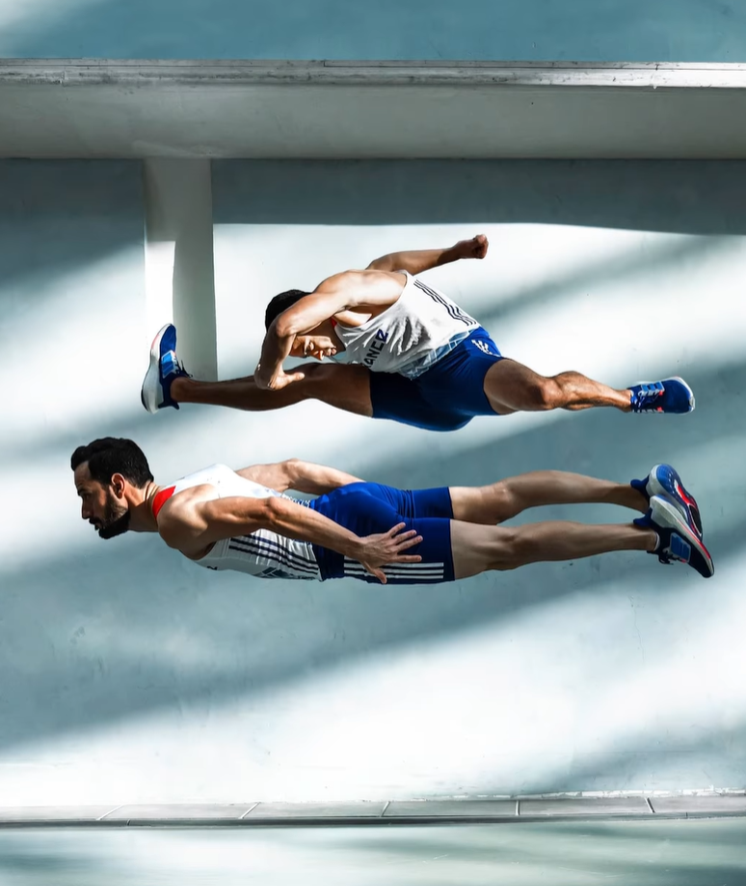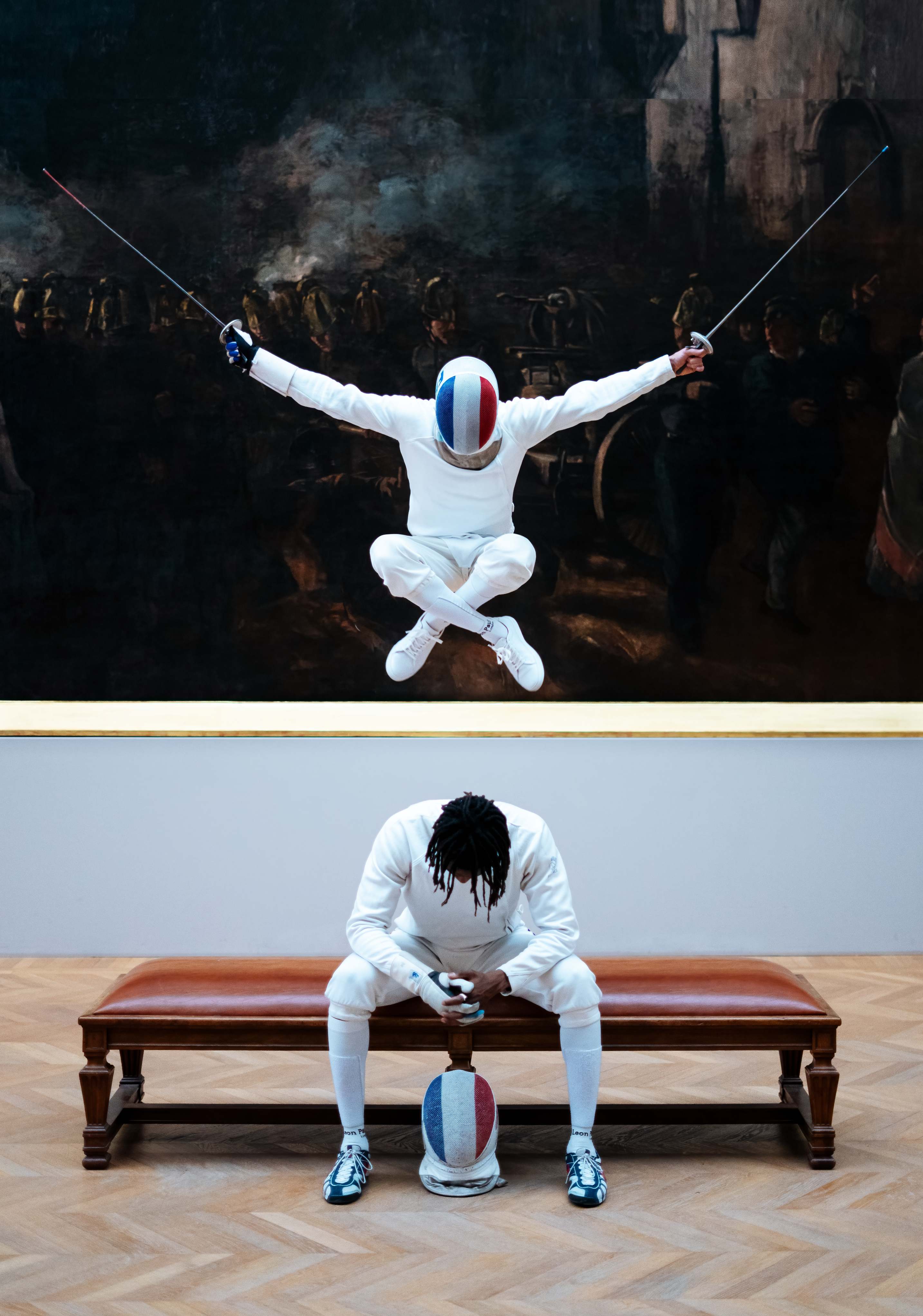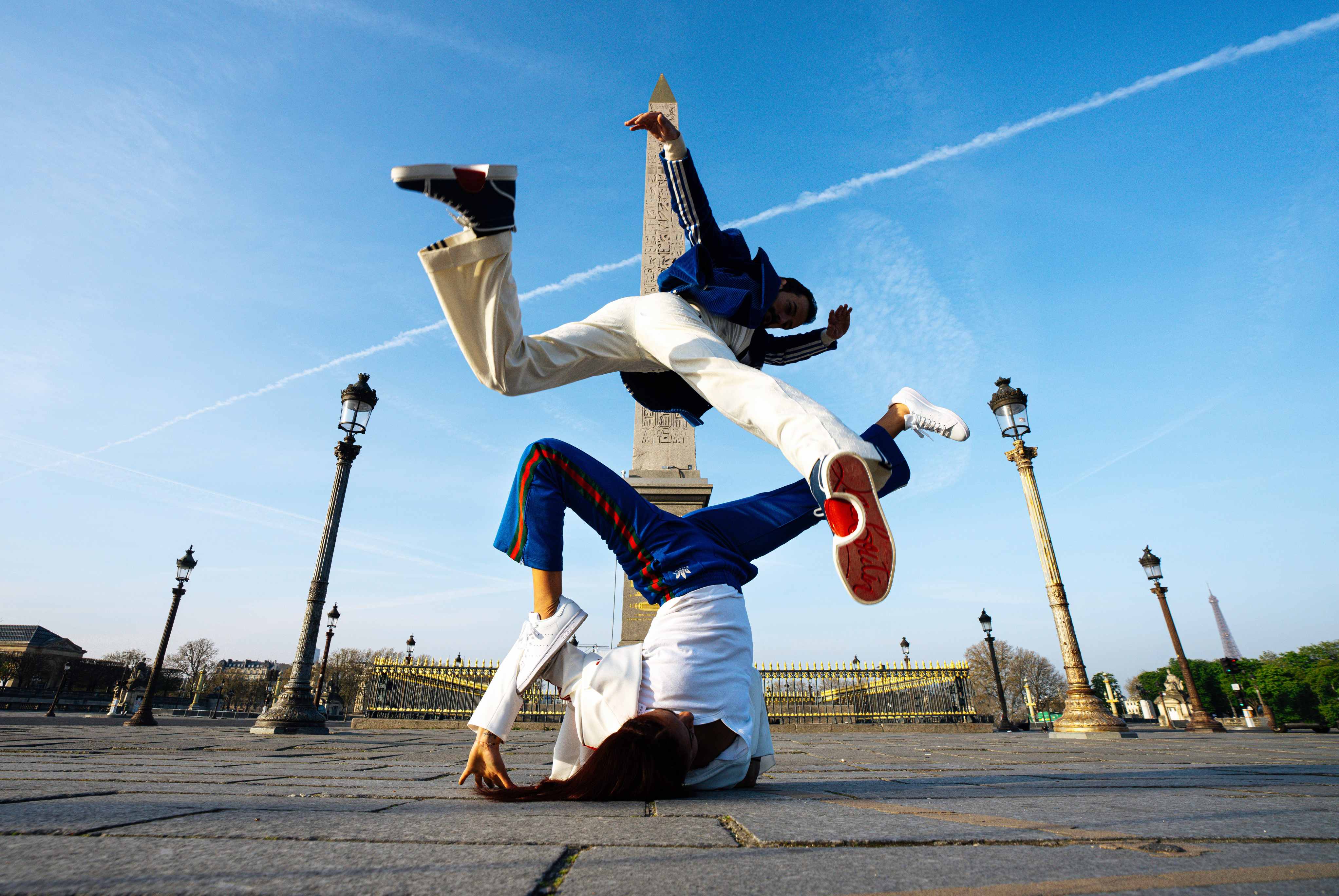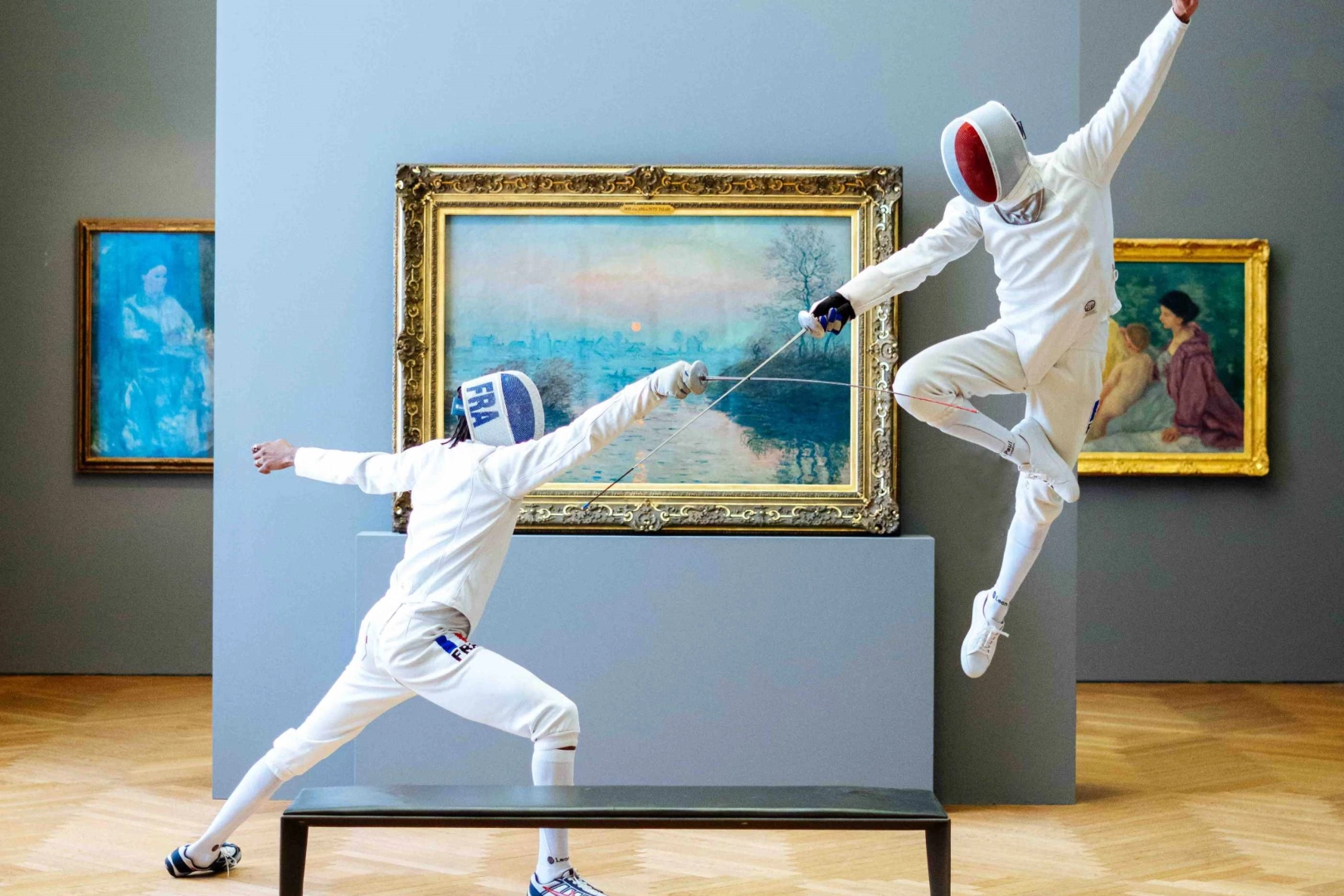Mathieu Forget, also known as Forgetmat is a world-renowned artist in the realm of movement, photography and performance. You may also know him as The Flying Man due to his incredible jumps where he defies gravity and levitates. Whenever he brings athletes to galleries or infuses art into sports fields, he creates artwork that captures the attention of millions of viewers.
Captivated by his distinctive artwork, I was eager to uncover the narrative behind his creative approach.- Mathieu's charm resonated with the joyful spirit of his work and his authenticity left a lasting impression. He shared with me how moments in sports can be perceived as a work of art, what skills are crucial to bringing his ideas alive, how architecture can strike an inspiration and which sport is close to his heart.
Join me for a journey through his vibrant world, where fencers battle in front of Monet's paintings, and where style, sport and art come together.

)
When we talk about sport and art, for me these two come together often unplanned. You see a football player scoring a great goal and think: “Oh my God, that was amazing! This is a work of art.“ So my first question for you is to what extent do you plan your artistic expressions and how much do you improvise?
First of all, I´d say that for me, the definition of an artist is someone who can elevate his talents, to the point that it becomes so fascinating that they transform it into art. Roger Federer is for me an artist of tennis, Messi is an artist of soccer and ballet dancers are artists of ballet. That's very similar to what you were saying. This vision of an artist is what pushes and inspires me. I just always try to be a better and stronger version of what I am now. Hopefully, one day people will say I'm an artist of the levitation movement, and an artist of blending, photography and dance. I'm trying to elevate whatever I'm doing to a point where it becomes something kind of undeniable. When it comes to my creations, there's always a part of production and a part of improvisation.
In The beginning, I would improvise a lot more because I would walk around with a camera in my bag, in New York and Los Angeles or wherever I was working and the location would inspire me and I would think “Oh, let me take a photo here.” A lot of groundwork was laid before that, with years and years of dancing and sports. So my body was ready. But then, capturing the moment and the movement, that became improvised.
Now this has been a real job for the last four years, and my projects are getting bigger and bigger. I have a team of two to five people with me anywhere I go so it can´t be like “Right, let's go out tomorrow and do something”. It takes a bit more preparation. But whenever I get on the spot I start to improvise with the athlete. I might have an idea in mind, but I always leave a place for improvisation.

Is there a particular place that stands out for you as an inspiration, perhaps where you find yourself returning often?
I think you can find inspiration everywhere. It can come from a beautiful building or the perfect lighting in the middle of the day. For me, fashion also plays a big part, because I studied costume design in college. I would see a woman with a beautiful red dress or a man with a cool green blazer and say: “Oh my God I would love to take a photo of that outfit”. In a place like Paris, there are always go-to spots for me whenever the historical bridges or modern architecture. I think I love everything that is very geometrical and has a lot of lines. And also minimalistic and empty places. It could be from a wall that's very grey with nothing on it to a salt lake in the middle of a desert.

Watching all your videos, I couldn't help but notice that when you move, jump, and perform, it appears so effortlessly. I'm aware there's a great deal of hard work behind it, yet you manage it with finesse, even in stylish clothes and in public spaces. I'm curious, what do you see as the limits to your expressions?
My limits? I would say mostly time and energy. I think there are no limits to creativity, no matter what we do, except the limits of your body and also the limitations of time in the day..
„
If I jump 50 times in a row, you know, after a while, I'm not going to be as agile as in the beginning. I will push myself, maybe adding more, but at one point you have to listen to your body; otherwise, you risk getting injured. And that can stop your activities for a much longer time.
You also have to be mindful of the time when capturing a moment and be attentive to the lighting, which is a significant aspect. And then knowing that I'm at the same time the photographer, the artistic director, but also the model.
When you were talking about the limitation of time, another thing that popped into my mind was the time frame you have on social media (reels or videos on TikTok). Since you are active on these platforms, do you think they play a role in shaping the art or do they offer a new perspective, perhaps bringing it closer to people?
First of all, I think a lot of artists come out through them and make a living out of them. Before social media or the internet was there, art was a lot more institutionalized and it was a lot harder to make it as an artist. It has become a new platform where you can present yourself. Now it's something that has to be taken into consideration, something that you can use or not use. I think there's good and bad in everything. I understand it as a way of communicating and displaying what you want to tell. I'm a very visual person and I love beautiful photos and beautiful visuals. It took me five years to get to 30,000 followers on Instagram by testing out different concepts, and different things.
„
Then TikTok arrived and now, my fifth video on TikTok got 50 million views.
But behind these short videos are hours of work.. I take it as another skill that I learned, outside of dance and photography, how to do short videos, filled with music that retains people's attention. YouTube is another format I'm trying to get into, but I just don't have yet the energy, the time or the skills. You can't do it all you have to decide on what platform you put your focus on. I think it's better to focus on one platform to develop instead of trying to do it all.
.jpg)
You have a strong background in sports. I would love to know in which sport you currently find your passion. Is there a particular sport that you would love, but haven't yet to present in your unique artistic style?
I was a professional tennis player, so tennis is close to my heart. Right now I have a cool photoshoot that I am realising with a tennis player Carolina Garcia. I'm also collaborating with a Paralympic tennis player. We created something really beautiful together. But my goal is to try and shoot an athlete in every sport until the Olympics. Another plan I have is to do something with skateboarding because I've always skated and I think it'd be cool. I don't know how, but it would be great to do kayaking or something on the water. And also handball. In all these collaborations, what's amazing is spending time with these athletes for a couple of hours. They teach me how to do things in a very short amount of time, and then I recreate and reimagine it with some sort of dance element. Every sport is fascinating when you try to extract something unique from it.
.jpg)
My last question relates to the upcoming Olympic Games in Paris and your work around it. Typically, what we see from you is that you are not accompanied by a lot of people. But these events attract massive crowds. Have you thought about incorporating this aspect into your work? Or have you considered how it would look in front of such an audience?
When it comes to my job and what you also see on social media, it’s the dance and the photography meshed together. But outside of this, I dance at events in front of crowds, such as the ongoing competition with an agency to potentially organize 11 shows across Paris when the Olympic flame passes through. The goal is to incorporate sport and dance into these shows. If we win, it would involve choreographing with around 30 athletes. I think it's always about opportunities and trying to push and challenge yourself creatively. So the sky's the limit.
You're right. Thank you so much. It was lovely talking to you. When I wrote to you on Instagram, I thought, well, let's just give it a try. I have nothing to lose, let's see. It's just great that you responded.
That's also how I started. I was trying to gain attention, be seen, and express myself, thinking that social media was a great platform for that. I began by sending emails and reaching out to photographers, asking if they would be interested in taking photos with me. I sent hundreds of messages, even if I didn't have a specific plan. As you rightly pointed out, at least if people don't respond, there's no harm, but if they do, something positive can come out of it. I always encourage others to take that initiative. When I receive messages like yours, I try to respond promptly, even though things can get busy. Setting up interviews, as you mentioned, involves planning, and things can unfold unexpectedly. So, keep pursuing opportunities, no matter what you do, as it always pays off. Thank you for reaching out.
Mathieu Forget alias Forgetmat is a world-renowned movement artist and creative director who specializes in movement and levitation art. Originally from Paris, dancer, photographer and performer, he embodies a new vision of dance that is both digital and real. Mathieu aspires to promote the freedom of expression, surpassing oneself and helping to mix styles. Also known as “The Flying Man”, thanks to his non-fake photos and videos reaching millions of views, Mathieu defies the laws of gravity through his levitating work. Passionated by architecture, he knows how to highlight the world that surrounds him by creating surreal and poetic concepts. This multi-disciplinary artist invites you to travel to an unknown land.
You can see his work on the website https://forgetmat.com/. You can also find him on Instagram as @forgetmat.





